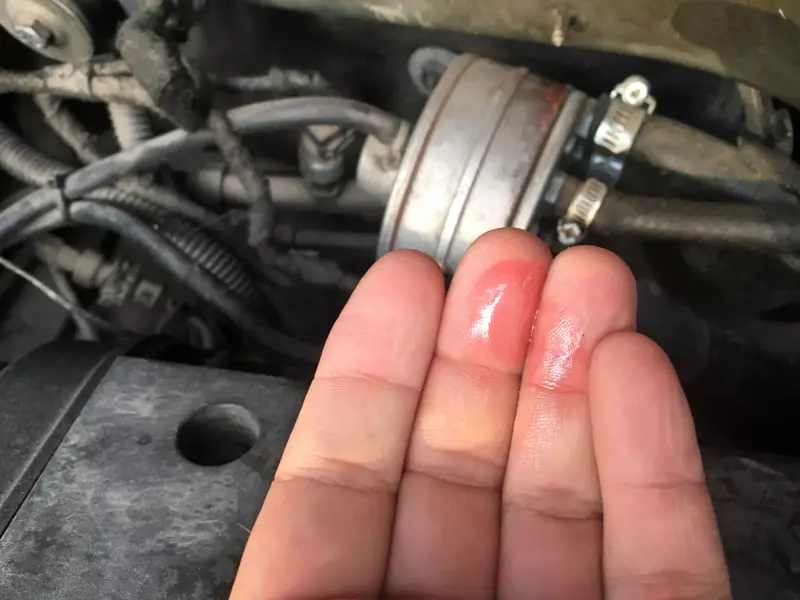As most of us know, leaking fluids from an automobile can be quite annoying. Especially after having done meticulous research throughout the buying process, the presence of leaking fluids from our cars can be extremely frustrating and potentially even deadly in some extreme cases. It's crucial to be able to determine what kind of fluid is leaking so that you can take the appropriate action to fix the problem. GoodCar is here to offer basic advice on what to do if you spot a leak as well as a color-coded reference for the various fluids that might be dripping from your automobile.
Red Fluid Leaks
What it means: Your car's power steering or gearbox may be leaking if you notice red fluid coming from it. It could also be brake fluid in some circumstances. Power steering fluid could be a darker red than transmission fluid, which is normally bright red. If you're unsure whether something is brake fluid, examine the consistency. Brake fluid can be either clear or amber in color. Transmission and power steering fluids are thicker than brake fluid, which is light and greasy.
What to do: Have your automobile checked out by a professional as soon as you can if you discover red fluid coming from it. Low amounts of brake fluid can impair your ability to stop, and low levels of transmission or power steering fluid can seriously harm your vehicle. You may top off the levels in the meantime by adding extra fluid, but this is only a temporary solution. If the fluid level falls fast once again, you probably have a leak that has to be fixed.
Orange or Green (or Pink or Yellow) Fluid Leaks
What it means: The most common cause of an orange or green fluid leak from your automobile is a radiator leak. Your engine's temperature may be controlled with the use of engine coolant, a solution made of water and antifreeze. Depending on the type of coolant your automobile uses, it can also be pink or yellow in color. Though most commonly, it is often bright orange or green.
What to Do: A coolant leak might seriously harm your engine by causing it to overheat. Immediately check the coolant levels in your automobile if you detect any orange, green, pink or yellow fluid dripping from it. To top them off if they're low, add extra coolant. But if the coolant level falls rapidly, you probably have a leak that has to be fixed as soon as possible by a licensed professional.
Clear Fluid Leaks

What it means: If you notice clear fluid dripping from your automobile, there are a number of potential causes. Engine oil, water, or even merely condensation from your air conditioning system might be considered clear fluid. In order to take the proper action, you must identify what is causing the leak.
What to Do: Try to locate the source of any clear fluid you observe dripping from your automobile. In many cases, it’s simply condensation coming from your air conditioner, so don't be concerned. Check the oil levels to make sure they are not too low if it is engine oil. If so, top them off with extra oil. But if the oil level falls rapidly, you probably have a leak that has to be addressed as soon as possible by a professional. If the clear fluid is water, it can come from the cooling system of your automobile. Unless you see a substantial amount of water coming from your automobile, this usually isn't a reason for alarm. Take your automobile to a mechanic to get it looked at if you're unsure of what's causing the leak.
Brown or Black Fluid Leaks
What it means: You probably have an oil leak if you notice brown or black liquid dripping from your automobile. This could be transmission fluid, engine oil, or differential fluid. Transmission and differential fluid are often lighter in color than engine oil, which is typically dark brown in hue.
What to do: If an oil leak is not fixed, it might seriously harm your engine. If you see brown or black fluid dripping from your automobile, ensure the oil levels aren't too low. If so, top them off with extra oil. On the other hand, if the oil level falls rapidly, you probably have a leak that has to be fixed. In this situation, have the leak corrected as quickly as you can by taking your automobile to a technician.
Blue Fluid Leaks
What it means: You probably have a leak in your windshield wiper fluid if you notice blue fluid coming from your automobile. The color of windshield wiper fluid is normally bright blue, but depending on the manufacturer, it can also be pink or yellow.
What to Do: A leak in windshield wiper fluid is often nothing to be concerned about. Nonetheless, you might want to get your automobile examined by a professional if you see a sizable volume of fluid coming from it.
When In Doubt, Ask Your Mechanic

Generally speaking, it is advisable to take your car to a trusted mechanic if you discover any leaks, but there are a few preventative measures you can take to help stave off leaks:
- Check your levels consistently: Regularly check the fluid levels in your vehicle, including the engine oil, transmission fluid, braking fluid, and coolant. If any of these fluids seem to be running low, top them up or get them refilled as necessary.
- Change your oil often: One of the most crucial things you can do to keep your automobile operating smoothly and avoid oil leaks is to replace your oil frequently. To find out how frequently you should change your oil, consult your owner's handbook.
- Keep a watch on your temperature gauge: If the red area of your car's temperature gauge begins to rise, your automobile may be overheating. It's crucial to fix this as soon as possible since it might lead to coolant leakage.
- Drive defensively: Avoid driving over speed bumps, potholes, and other uneven road surfaces since they can harm your car's underside and result in leaks.
Dealing with fluid leaks in your automobile might be unpleasant, but it's critical to act quickly to limit further damage and guarantee your safety while driving. You can maintain your automobile operating efficiently for many years by being aware of the various fluid leaks and taking precautions to stop them from happening.








![Best Sites to Check a Car’s History [2025 Review]](https://media.infopay.net/thumbnails/K8lMeG2QLjE46LPqZlmoi6SunKKdT5qvlaRZk6e1.webp)










![Best Sites to Check a Car’s History [2025 Review]](https://media.infopay.net/thumbnails/K8lMeG2QLjE46LPqZlmoi6SunKKdT5qvlaRZk6e1-w356.webp)
